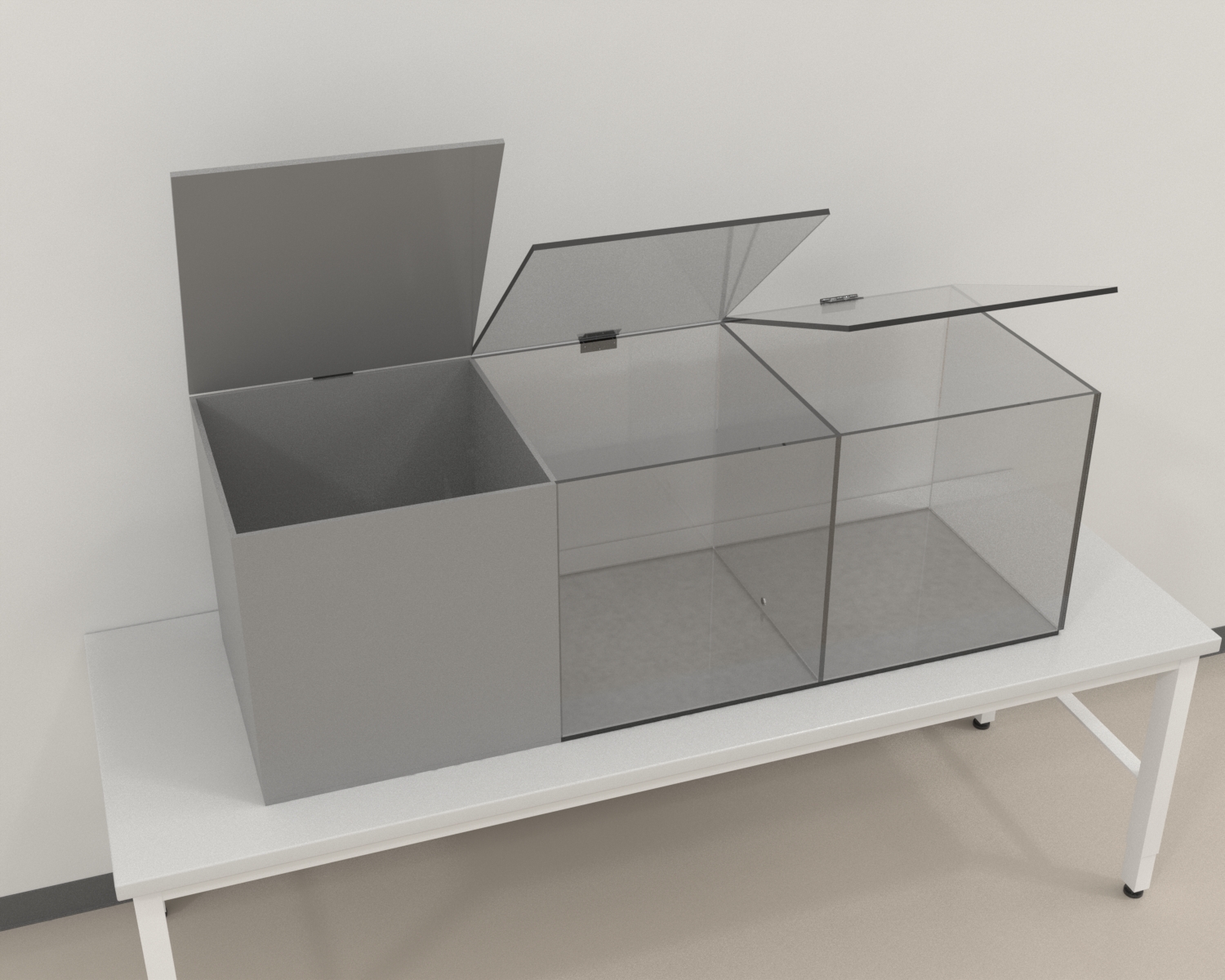Ethological Motivated Light/Dark Box Social Interaction Test is an adaption of the traditional Light/Dark box. Ethological Motivated Light/Dark Box is used to study a wide range of neurodegenerative and social affective disorders as well as associated neurological structures within the interdisciplinary fields of neuroscience, neuropsychology, neuropsychiatry, and neuropsychopharmacology.
Maze Engineers offers the Ethological Motivated Light/Dark Box Social Interaction Test.
Price & Dimensions
Ethological Motivated Light/Dark Box Social Interaction Test for Mouse
$ 3290
Per Month- Three acrylic chambers. 12” x 12” x 12” (each chamber).
- 2 Clear Chambers, 1 Dark Color Chamber.
- Social hole 1/4” off the floor.
- Clear flip-up lids for each chamber 12” x 12.5”
- Escape hole from dark chamber to clear 4.25” into the center, 3” diameter, 1/4” off the floor.
Ethological Motivated Light/Dark Box Social Interaction Test for Rat
$ 3690
Per Month- Three acrylic chambers. Each chamber is 24” x 24” x 24”.
- 2 Clear Chambers, 1 Dark Chamber.
- Social hole ½” off the floor.
- Clear flip-up lids for each chamber 24”-25”
- Escape hole from dark chamber to clear 8.5” into the center, 6” diameter, ½” off the floor.
Light/Dark Box Social Interaction Test Documentation
Learn MoreHave questions? Inquiries?
Contact UsIntroduction
The Ethological Motivated Light/Dark Box was developed and adapted from the traditional Light/Dark Box and traditional Sociability chamber to assess the limitations of scoring and viewing natural ethological rodent behaviors (Neurwirth et al., 2017). The Ethological Motivated Light/Dark Box allows for the study of re-habituation and latency between stranger interactions. This apparatus is targeted at investigating the relationships of the frontal cortex, amygdala, and hippocampal brain structures. This apparatus can be used for the assessment of these brain structures and genetic, epigenetic, or environmental factors in social affective disorders such as ADD and ADHD, Autism, Alzheimer’s Disease, Parkinson’s Disease, Schizophrenia, and environmentally induced social learning disabilities.
Through understanding the involvement of social motivation and visual recognition during learning, this apparatus addresses how these learning behaviors may interfere with early or late memory formation/encoding and consolidation or reconsolidation in real-time conscious states in social contexts. Moreover, the Ethological Motivated Light/Dark Box can also be used to observe the effect of different pharmacological and genetic manipulations, brain lesions, and more on neurodegenerative and social affective disorders.
The Ethological Motivated Light/Dark Box can be reliably used for visual demonstrations of neuro-social behaviors of rodents and to record real-time accurate data.
Apparatus & Equipment
The Ethological Motivated Light/Dark Box Social Interaction Test consists of three chambers, two clear chambers, and one dark chamber. Each chamber is 12 x 12 x 12 inches (mouse size), clear flip-up lids for each chamber are 12 x 12.5 inches, and an escape hole from the dark chamber to the clear chamber, 4.25 inches into the center, 3-inch diameter, 1/4 inch off the floor.
Training Protocol
Clean the apparatus after every trial to prevent odor cues from previous trials affecting task performance. Appropriately light the apparatus. A tracking and recording system such as the Noldus Ethovision XT can be used to assist with observations.
Stranger to test rodent combinations can include an old stranger to younger test rodents and vice versa. Gender combinations can also be examined using this apparatus.
Pre-training Protocol.
- Place the testing room at 6 Lux in illumination.
- Stranger introduction: Introduce the “stranger” rodent to the social chamber three times a day for ten minutes.
- Score nervous behaviors (biting, circling, excessive grooming, etc) of stranger rodents until there is a 70% reduction in these behaviors. The stranger rodent is now ready to use as testable strangers. Use a rotation of 3 strangers during testing.
Testing
- Testing day 1: Place test rodent in light/ dark box portion of the apparatus, allow for acclimatization for 10 mins.
- Testing day 2: Place the test rodent in the light/ dark box portion of the apparatus and the stranger rodent in the social chamber. In ten minutes the following parameters can be measured:
- Time spent at the social hole.
- Time spent in light / dark chambers.
- Latency time between social hole interaction and time spent in the dark chamber.
- For social deficit studies such as in rodent autism models, novel objects can be placed within the social chamber
Data Analysis
The following parameters can be observed using the Ethological Motivated Light/Dark Box Social Interaction Test:
- Time spent at the social hole.
- Time spent in light / dark chambers.
- Latency time between social hole interaction and time spent in a dark chamber.
Strengths & Limitations
Strengths
As an adaption of the traditional Light/Dark box, Ethological Motivated Light/Dark Box can be used to study a wide range of neurodegenerative and social affective disorders and associated neurological structures within the interdisciplinary fields of neuroscience, neuropsychology, neuropsychiatry, and neuropsychopharmacology.
Limitations
After each trial, the Ethological Motivated Light/Dark Box must be cleaned to prevent lingering odor cues from previous trials from affecting task performance. Social interaction behaviors of the subjects are essential for task performance. The subjects’ age, gender, or strain can affect the way they perform the task. Stress from inappropriate or aggressive handling of the subjects can affect task performance. Unintentional stimuli may interfere with task performance.
References
- Neuwirth LS, Volpe NP, Corwin C, Ng S, Madan N, Ferraro AM, Furman Y, El Idrissi A. Taurine Recovery of Learning Deficits Induced by Developmental Pb2+ Exposure. Adv Exp Med Biol. 2017;975 Pt 1:39-55. DOI: 10.1007/978-94-024-1079-2_4. PMID: 28849442.

